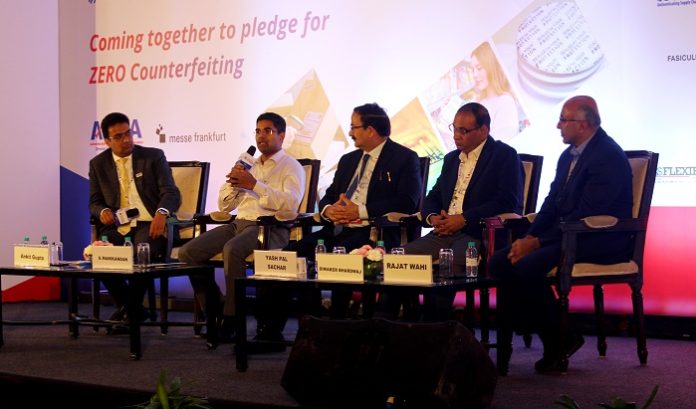
The threat posed by counterfeit products, especially in the pharma sector, and how to deal with it was the key focus of the fifth Traceability and Authentication Forum organized by the Authentication Solution Provider’s Association (ASPA) and Messe Frankfurt on 6 -7 July 2023 at Delhi’s Hyatt Regency.
Day I of the two-day conference, co-organized by Messe Frankfurt, gave an overview of the counterfeiting landscape in India, the steps being taken to empower consumers to identify fakes, the critical emerging threats that brands face from duplicate products, and how traceability and active and Intelligent packaging can help deal with the problem.
Stakeholders and experts from different sectors felt traceability and authentication need to take center stage to prevent counterfeit products from reaching the consumer as they hamper a brand’s credibility. They stressed the need to increase awareness and facilitate identification methods to secure the supply chain.
The rising threat
One in four Indian consumers has been a victim of fake products. According to a recent report by ASPA and credit rating agency Crisil on the ‘State of Counterfeiting in India 2022’, fakes constitute almost 25-30% of products and are most prevalent in sectors such as agro-industries, apparel, automotive, consumer electronics, FMCG, pharmaceuticals among others. As much as 27% of consumers are unaware of counterfeit products at the time of purchase, making it all the more important to spread awareness about the issue and how to identify fakes.
The packaging industry has reached an alarming situation wherein on the one hand new technology facilitates an improved consumer experience, on the other it enables the counterfeiters to make almost exact replicas of a product. The concerns have now reached a threshold where the active participation of the provider and the consumer is of much more significance.
Awareness a must
Sudeep Goenka, director of Goldiee Group, a spice maker, said, “Awareness must be created among the consumers as well as the solution providers. The problem with counterfeit products is that it is possible to replicate packaging. Enhancement in traceability is a solution — QR codes, monograms, labels, and bar codes.”
Sanjay Gupta, vice-president of FMCG conglomerate DS Group, said, “Reacting when counterfeits are found is of little value. Industry professionals need to act beforehand to influence a better brand impact — safeguarding the trust of the consumer. A counterfeit department needs to be established in all segments of the industry and needs to be functional at every step, right from transit to reaching the end consumer.”
Active and Intelligent Packaging
In an interactive presentation on ‘Innovation for the Future: Active and Intelligent Packaging’, Naresh Khanna, editor of Packaging South Asia said, that the future is now. “Active and intelligent packaging is when the packaging can relay the information of its contents. Not in a conventional manner, but the packaging should be able to tell if the condition of contents is deteriorating due to a temperature change or other variables as specified on the packaging of any product. Indicators can be either the change in color of the entire packaging or a litmus reaction at a specified part. The packaging should also be able to tell if the contents are safe for the consumer.”

An advanced ecosystem to prevent counterfeits is the need of the hour, said Sanket Randive, head of corporate quality assurance of leading multinational Marico. “A behavioral change needs to be implemented. The option of tracing the product by scanning a QR or a bar code has been there for ages. Being a consumer myself I don’t scan the codes. If I purchase a pack of Surf, I am simply assured that I have a pack of Surf when needed. That would need to change. The profit margins also dwindle due to counterfeits and delayed reaction adds to the waste of time and money.”
Industry’s role
Kumaresh Misra, director of the Indian Chemical Council, said the industry needs to take an active role in influencing regulatory decisions of the government.
“Technical people are not at the top decision-making bodies in the government. Instead of asking the government what is to be done to prevent counterfeits, we, who have the technical know-how, need to tell the government how to proceed. The urgency of collaboration between the public and private sectors is now more than ever. However, everyone needs to be on the same page and focus on solutions for targeted problems.”
(Next: Day 2 – How holograms and QR codes can help)







